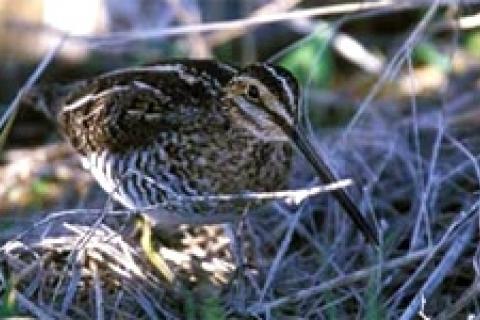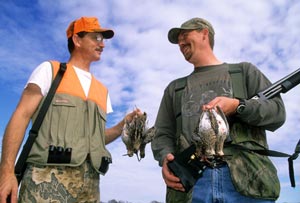
No rabbits. No woodcocks. No quail. The coverts we hunted proved barren on a recent hunt in east Arkansas' Pine Tree Wildlife Management Area. After four hours of brush-busting, we loaded up and headed home, frustrated and empty-handed.
 |
| Arkansas hunters Lewis Peeler, left, and Josh Sutton pose with the snipe taken during a successful hunt. |
"What now?" I asked. My friend Lewis shrugged, but Josh, my oldest son, had a suggestion. "I know a field where we might find some arrowheads," he said.
Minutes later, we were there. But instead of hunting arrowheads, we found an even greater prize: snipe! The muddy farm field contained hundreds of these drab shorebirds. At first, however, we were uncertain what they were. I grabbed some binoculars and looked.
A quick glance confirmed my suspicions. They were Wilson's snipe, also known as jacksnipe. All the field marks were evident — an extremely long bill, a distinctive striped head and a rust-colored tail. Each bird was the size of a skinny quail. In flight, they resembled winged golf balls carrying their own tees.
"Want to go on a snipe hunt?" I asked. Lewis and Josh looked puzzled, but with good reason. Like thousands of hunters, this pair once had been targets of a hoary prank in which a scared kid is taken into a marsh at night, carrying a lantern and a burlap sack with which to catch the snipe other members of the party say they will drive to him. The others go home and leave the unfortunate to fret over a thousand spooky swamp noises. Such "snipe hunts" have been practiced for decades, and it's sometimes difficult to convince rational people there really is such a thing as a snipe, and there really is such a thing as snipe hunting with guns.
Convince them I did, however. And as Lewis and Josh soon found out, snipe hunting — the real kind — can be blast.
We loaded our shotguns and began making our way across the field in ankle-deep gumbo. Lesson No. 1 of snipe hunting was quickly learned: Wear rubber boots and prepare for intense muscular exertion.
The walking is often through water and mud up to the knees, or one may have to pick his way through a soft marsh, springing from tussock to tussock, with every prospect of tumbling from those unsteady resting places into mire of unknown depth.
The snipe shooter, therefore, should carry no extra weight. His shotgun should be light, and his cartridges need hold no more than an ounce of No. 8 or 9 shot, for this bird is easily killed, and it is so small and so often flushes at a considerable distance, it is important that as many pellets as possible be sent after it.
Several wisps of snipe took flight as we approached, and as each of us swung on a longbill, we were confronted with Lesson No. 2: A fleeing snipe has no idea where it's going, which makes shooting one very difficult.
 |
| The snipe hunter's boots: always wet and muddy. |
When flushed, most gamebirds start a particular line of flight and keep to it. Not so with the snipe. This bird takes flight, darts a few yards one way, changes its mind and turns at right angles to its original course; then it appears to think it has made a mistake, and once more alters its direction. The bird then either flies high in the air and circles for a while, looking for a desirable spot to alight, or settles into a straight, swift course that doesn't end until the snipe forgets it is frightened. This eccentric flight pattern puzzles many sportsmen, and some who are capital shots at other birds can never calculate the movements of snipe.
So it was for our trio of snipe hunters, at least during the opening volleys of that hunt. If we zigged, the snipe zagged. When we swung left, the snipe veered right. Many rounds were fired, yet the snipe remained unscathed. We followed them all over that field, leaving a trail of empties behind us. I decided if we ever did bag one, it would be as costly a bit of fowl as was ever put on a table.
Bag one we did, however, then another and another and another. For the snipe has another trait that is endearing, rather than irritating, to the hunter. When they have not been hunted, these "shad spirits," as they're sometimes called, often drop back to the ground a few yards from where they flushed. Some birds fly straight up until just specks in the sky, then plummet back and light near the same spot from which they took off.
The problem here lies in marking birds down, for snipe with their amazing camouflage are ghosts on the ground. Even when you mark one carefully and search the ground ahead as you approach, you often fail to see it. The bird squats motionless, and just as you decide you have made a mistake in marking it, it jumps from the spot where you have just looked.
Hunting pressure makes the birds steadily wilder, even though it may not cause them to abandon good areas. After just one day of shooting, the birds may get so spooky that you're wasting your time, and it's possible to walk for hours, putting up scores of snipe, without a single one in range.
After Lewis, Josh and I had each burned up half a box of shells, we were wise to some of these tricks. We figured out that snipe usually rise against the wind, and by advancing on them with the wind at your back, they are forced to fly toward you for some distance, thus allowing a shot at fair range. We also learned that a snipe cannot be shot too quickly, especially if it rises more than 15 yards from the shooter (and they seldom rise closer). Take aim and shoot — fast.
Open marshes, rice fields, lake and stream edges, shallow drainage ditches and damp mud flats all are prime hunting areas if the cover is not too thick to allow snipe access to the soil. If the ground freezes, however, or becomes iced over, the snipe will leave, for they feed by probing the soft earth with their long bills.
 |
| The snipe's superb camouflage makes it difficult to see on the ground. (U.S. Fish and Wildlife Service photo) |
You also should be aware of Lesson No. 3: Snipe are uncertain birds.
One may find them on a particular piece of ground in great numbers one day, then return the next and find they have completely disappeared. A muddy field that afforded splendid shooting at evening may be visited at dawn the next day, and the birds will have departed. Happy is the man, therefore, who finds plentiful snipe, and wise is the snipe hunter who takes advantage of the present opportunity. The advice, Carpe diem ("Seize the day"), certainly applies when gunning for these extraordinary gamebirds.
After four hours of almost nonstop shooting, Lewis had bagged six snipe, Josh five. And me ... well, let's just say I wasn't as quick a learner as those two. I scored once and fired 50 shells.
I did learn one thing, though. Lesson No. 4: When other game animals are scarce, snipe can save the day.
These skinny little shorebirds can be hard to hunt and even harder to hit. But when you're in the mood for some for fun, fast-paced gunning, snipe are hard to beat. They're abundant, widespread and excellent on the table.
Next time someone asks if you want to go snipe hunting, don't be too quick to call their bluff. You just might be in for some of the best wingshooting of the season.
|
Butterflied Snipe Basted With Shallot Butter In addition to being fun to hunt, snipe are among our most delectable gamebirds. Here's a great way to prepare them.
Cut along the backbone of each snipe with kitchen shears. Open up the birds, and flatten each by pressing on the breastbone with the heel of your hand. Lightly salt both sides. In a small bowl combine butter and shallots until well blended. Set aside. Place snipe, breast side down, on grill; sear. Turn; sear other side. Grill the birds, brushing frequently with the shallot butter, about 10 minutes, turning once. Serves 2 to 4. |
- 7715 views

